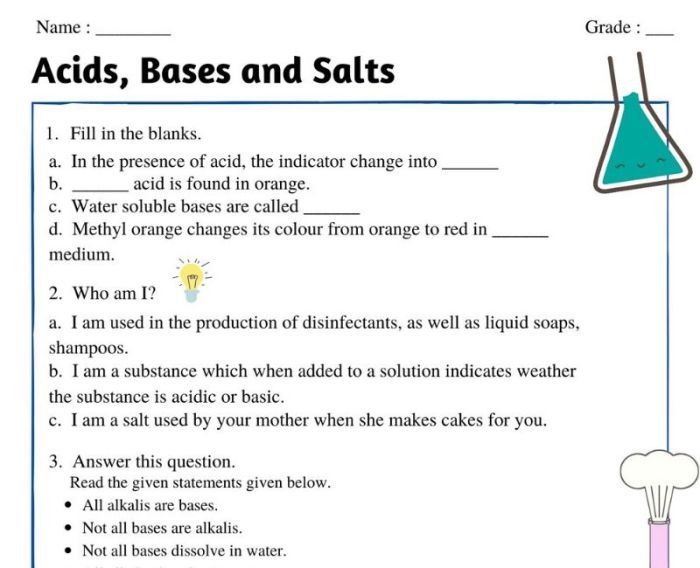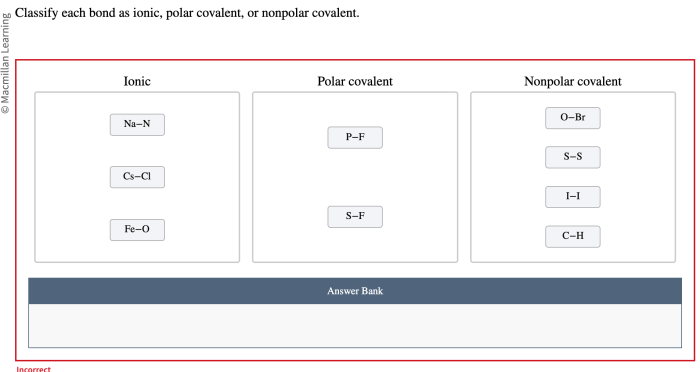Acids bases and salts worksheet answers – Acids, bases, and salts worksheet answers provide a comprehensive understanding of these fundamental chemical concepts. This guide delves into the definitions, properties, reactions, and applications of acids, bases, and salts, equipping readers with a thorough grasp of their significance in various fields.
Acids, bases, and salts play crucial roles in industrial processes, everyday life, and the environment. By exploring their characteristics and reactions, we gain insights into their diverse applications and the importance of their responsible use.
Acids, Bases, and Salts Definitions

Acids and bases are two important classes of chemical compounds that exhibit distinct properties and play crucial roles in various chemical reactions. Salts, on the other hand, are ionic compounds formed by the neutralization of acids and bases.
Acids
- Acids are substances that donate protons (H+ ions) in aqueous solutions.
- They have a sour taste and turn blue litmus paper red.
- Common examples of acids include hydrochloric acid (HCl), sulfuric acid (H2SO4), and acetic acid (CH3COOH).
Bases
- Bases are substances that accept protons (H+ ions) in aqueous solutions.
- They have a bitter taste and turn red litmus paper blue.
- Common examples of bases include sodium hydroxide (NaOH), potassium hydroxide (KOH), and ammonia (NH3).
Salts
- Salts are ionic compounds formed when an acid reacts with a base.
- They are typically neutral in nature, meaning they do not have acidic or basic properties.
- Common examples of salts include sodium chloride (NaCl), potassium nitrate (KNO3), and calcium carbonate (CaCO3).
Properties of Acids, Bases, and Salts
Characteristic Properties
- Acids are typically corrosive and can cause burns.
- Bases are slippery and can cause irritation.
- Salts are generally solids at room temperature and are soluble in water.
pH Scale
The pH scale is a measure of the acidity or alkalinity of a solution. It ranges from 0 to 14, with 7 being neutral. Solutions with a pH below 7 are acidic, while those with a pH above 7 are basic.
Key Properties
| Property | Acids | Bases | Salts |
|---|---|---|---|
| Taste | Sour | Bitter | Neutral |
| pH | <7 | >7 | 7 |
| Reaction with Litmus | Turns blue litmus red | Turns red litmus blue | No reaction |
| Electrical Conductivity | Good conductors | Good conductors | Poor conductors |
Reactions Involving Acids, Bases, and Salts
Neutralization Reactions
Neutralization reactions occur when an acid and a base react to form a salt and water. These reactions are exothermic, meaning they release heat.
For example, the reaction between hydrochloric acid (HCl) and sodium hydroxide (NaOH) produces sodium chloride (NaCl) and water (H2O):
HCl + NaOH → NaCl + H2O
Titration
Titration is a technique used to determine the concentration of an unknown acid or base solution. It involves slowly adding a known concentration of base or acid to the unknown solution until the reaction is complete.
Reactions with Metals and Carbonates
- Acids react with metals to produce hydrogen gas.
- Bases react with carbonates to produce carbon dioxide gas.
Applications of Acids, Bases, and Salts
Industrial Uses
- Acids are used in the production of fertilizers, plastics, and dyes.
- Bases are used in the production of soaps, detergents, and paper.
- Salts are used in the preservation of food, as fertilizers, and in water softeners.
Everyday Life, Acids bases and salts worksheet answers
- Acids are used in food preservation (e.g., vinegar in pickles) and in batteries.
- Bases are used in cleaning products (e.g., ammonia in window cleaners) and in medicines (e.g., antacids).
- Salts are used in table salt, baking soda, and fertilizers.
Environmental Impact
The improper disposal of acids and bases can have a negative impact on the environment. Acids can acidify water bodies, while bases can cause eutrophication.
It is important to use acids and bases responsibly and to dispose of them properly.
Top FAQs: Acids Bases And Salts Worksheet Answers
What is the difference between an acid and a base?
Acids are substances that donate protons (H+ ions), while bases are substances that accept protons.
What is the pH scale?
The pH scale measures the acidity or alkalinity of a solution, with a pH below 7 indicating acidity and a pH above 7 indicating alkalinity.
What is neutralization?
Neutralization is a reaction between an acid and a base that results in the formation of a salt and water.
